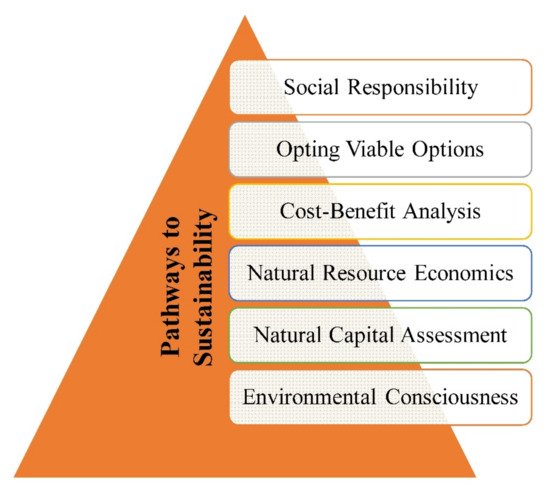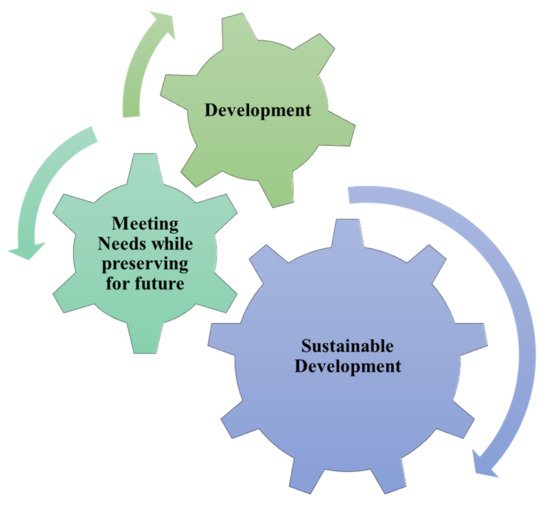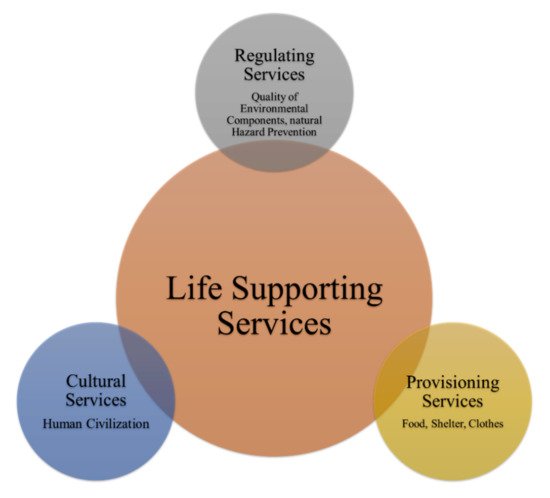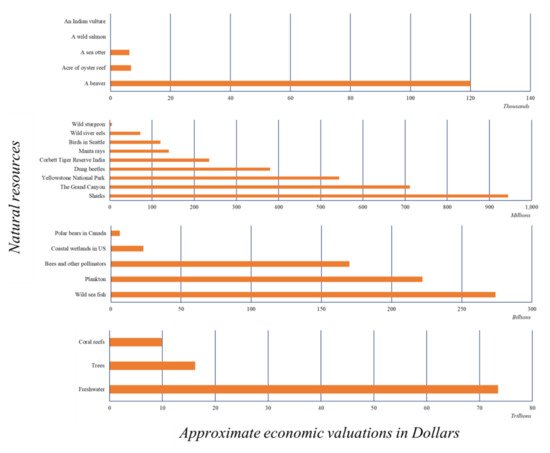Natural capital is the wealth of nations that determine their economic status. Worldwide, vulnerable people depend on natural capital for employment, salaries, wealth, and livelihoods and, in turn, this determines the developmental index of the nation to which they belong. In this short review, we have tried to sum up the ideas and discussions over natural capital’s role in ascribing economic status to countries as well as the need for natural resource management and sustainability. This paper aimed to discuss how humanity’s prosperity is intertwined with the services that ecosystems provide, and how poor natural resource management (NRM) has adversely affected human well-being. Our preselected criteria for the review paper led us to evaluate 96 peer-reviewed publications from the SCOPUS database, which is likely the most comprehensive archive of peer-reviewed scientific literature as well as WoS, PUBMED, and Google Scholar databases. Our review revealed that the availability of ecological services is crucial for clean water and air, food and fodder, and agricultural development. We further discussed important concepts regarding sustainability, natural capital and economics, and determinants of human well-being vis-à-vis the intergenerational security of natural wealth. To ensure current and future human well-being, we conclude that an in-depth understanding of the services that ecosystems provide is necessary for the holistic management of the Earth system.
- ecosystem services
- natural resource management
- natural capital
- environmental economics
- environmental sciences
- tragedy of commons
- environmental valuation
1. Introduction
2. Natural Resource Management (NRM)—Key to Sustainability
2.1. NRM and Natural Capital

2.2. Humans and Eco-Service Values
2.3. Natural Resources-Based Capital and Employment

2.4. Poor Natural Resource Management and Costs to Human Well Being
References
- Zakaria, F. From Wealth to Power: The Unusual Origins of America’s World Role; Princeton University Press: Princeton, NJ, USA, 1999.
- Monfreda, C.; Wackernagel, M.; Deumling, D. Establishing national natural capital accounts based on detailed ecological footprint and biological capacity assessments. Land Use Policy 2004, 21, 231–246.
- Meraj, G. Ecosystem service provisioning–underlying principles and techniques. SGVU J. Clim. Chang. Water 2020, 7, 56–64. Available online: https://www.gyanvihar.org/journals/wp-content/uploads/2020/06/MS-JCCW05.pdf (accessed on 1 June 2021).
- Blanco, E.; Razzaque, J. Globalisation and Natural Resources Law: Challenges, Key Issues and Perspectives; Edward Elgar Publishing: Cheltenham, UK, 2011.
- Andrews, R.N. Managing the Environment, Managing Ourselves: A History of American; Environmental Policy; Yale University Press: New Haven, CT, USA, 2006.
- Baromey, N. Ecotourism as A Tool for Sustainable Rural Community Development and Natural Resources Management in the Tonle Sap Biosphere Reserve; Kassel University Press GmbH: Kassel, Germany, 2008.
- Messerli, P.; Murniningtyas, E.; Eloundou-Enyegue, P.; Foli, E.G.; Furman, E.; Glassman, A.; Hernández Licona, G.; Kim, E.M.; Lutz, W.; Moatti, J.P.; et al. Global Sustainable Development Report 2019: The Future is Now–Science for Achieving Sustainable Development. 2019. Available online: http://pure.iiasa.ac.at/id/eprint/16067/1/24797GSDR_report_2019.pdf (accessed on 1 June 2021).
- Palmquist, R.B. Property Value Models, Handbook of Environmental Economics; Elseiver: Amsterdam, The Netherlands, 2005; Volume 2, pp. 763–819.
- McWilliams, A.; Siegel, D. Corporate social responsibility: A theory of the firm perspective. Acad. Manag. Rev. 2001, 26, 117–127.
- Van der Ploeg, R. Sustainable management of natural resource wealth. In National Wealth: What Is Missing, Why It Matters; Hamilton, K., Hepburn, C., Eds.; Oxford University Press: Oxford, UK, 2017.
- Romp, W.; De Haan, J. Public capital and economic growth: A critical survey. Perspekt. Wirtsch. 2007, 8, 6–52.
- De Ferranti, D.; Perry, G.E.; Lederman, D.; Maloney, W.E. From Natural Resources to the Knowledge Economy: Trade and Job Quality; The World Bank: Washington, DC, USA, 2002.
- Rist, S.; Chidambaranathan, M.; Escobar, C.; Wiesmann, U.; Zimmermann, A. Moving from sustainable management to sustainable governance of natural resources: The role of social learning processes in rural India, Bolivia and Mali. J. Rural Stud. 2007, 23, 23–37.
- Tolessa, T.; Senbeta, F.; Kidane, M. The impact of land use/land cover change on ecosystem services in the central highlands of Ethiopia. Ecosyst. Serv. 2017, 23, 47–54.
- Sallustio, L.; Munafò, M.; Riitano, N.; Lasserre, B.; Fattorini, L.; Marchetti, M. Integration of land use and land cover inventories for landscape management and planning in Italy. Environ. Monit. Assess. 2016, 188, 48.
- Li, X.; Gong, P. Urban growth models: Progress and perspective. Sci. Bull. 2016, 61, 1637–1650.
- Amsden, A.H. Escape From Empire: The Developing World’s Journey through Heaven And Hell; MIT Press: Cambridge, MA, USA, 2009.
- Benedetti, Y.; Morelli, F.; Munafò, M.; Assennato, F.; Strollo, A.; Santolini, R. Spatial associations among avian diversity, regulating and provisioning ecosystem services in Italy. Ecol. Indic. 2020, 108, 105742.
- Strollo, A.; Smiraglia, D.; Bruno, R.; Assennato, F.; Congedo, L.; De Fioravante, P.; Giuliani, C.; Marinosci, I.; Riitano, N.; Munafò, M. Land consumption in Italy. J. Maps 2020, 16, 113–123.
- Costanza, R.; de Groot, R.; Braat, L.; Kubiszewski, I.; Fioramonti, L.; Sutton, P.; Farber, S.; Grasso, M. Twenty years of ecosystem services: How far have we come and how far do we still need to go? Ecosyst. Serv. 2017, 28, 1–16.
- Meraj, G.; Khan, T.; Romshoo, S.A.; Farooq, M.; Rohitashw, K.; Sheikh, B.A. An integrated geoinformatics and hydrological modelling-based approach for effective flood management in the Jhelum Basin, NW Himalaya. Multidiscip. Digit. Publ. Inst. Proc. 2018, 7, 5804.
- Meraj, G.; Romshoo, S.A.; Ayoub, S.; Altaf, S. Geoinformatics based approach for estimating the sediment yield of the mountainous watersheds in Kashmir Himalaya. India. Geocarto Int. 2018, 33, 1114–1138.
- Chagnon, M.; Kreutzweiser, D.; Mitchell, E.A.; Morrissey, C.A.; Noome, D.A.; Van der Sluijs, J.P. Risks of large-scale use of systemic insecticides to ecosystem functioning and services. Environ. Sci. Pollut. Res. 2015, 22, 119–134.
- Kanga, S.; Meraj, G.; Das, B.; Farooq, M.; Chaudhuri, S.; Singh, S.K. Modeling the spatial pattern of sediment flow in lower Hugli estuary, West Bengal, India by quantifying suspended sediment concentration (SSC) and depth conditions using geoinformatics. Appl. Comput. Geosci. 2020, 8, 100043.
- Rather, M.A.; Farooq, M.; Meraj, G.; Dada, M.A.; Sheikh, B.A.; Wani, I.A. Remote sensing and GIS based forest fire vulnerability assessment in Dachigam National park, North Western Himalaya. Asian J. Appl. Sci. 2018, 11, 98–114.
- Barletta, M.; Jaureguizar, A.J.; Baigun, C.; Fontoura, N.F.; Agostinho, A.A.; Almeida-Val, V.M.F.D.; Val, A.L.; Torres, R.A.; Jimenes-Segura, L.F.; Giarrizzo, T.; et al. Fish and aquatic habitat conservation in South America: A continental overview with emphasis on neotropical systems. J. Fish Biol. 2010, 76, 2118–2176.
- Hermes, J.; Van Berkel, D.; Burkhard, B.; Plieninger, T.; Fagerholm, N.; Haaren, C.; Albert, C. Assessment and valuation of recreational ecosystem services of landscapes. Ecosyst. Serv. 2018, 31, 289–295.
- De Groot, R.; Brander, L.; van der Ploeg, S.; Costanza, R.; Bernard, F.; Braat, L.; Christie, M.; Crossman, N.; Ghermandi, A.; Hein, L.; et al. Global estimates of the value of ecosystems and their services in monetary units. Ecosyst. Serv. 2012, 1, 50–61.
- Costanza, R.; Alperovitz, G.; Daly, H.; Farley, J.; Franco, C.; Jackson, T.; Kubiszewski, I.; Schor, J.; Victor, P. Building a sustainable and desirable economy-in-society-in-nature. In State of the World; Island Press: Washington, DC, USA, 2013.
- Balthazar, V.; Vanacker, V.; Molina, A.; Lambin, E.F. Impacts of forest cover change on ecosystem services in high Andean mountains. Ecol. Indic. 2015, 48, 63–75.
- Kanu, B.S.; Salami, A.O.; Numasawa, K. Inclusive growth: An imperative for African agriculture. Afr. J. Food Agric. Nutr. Dev. 2014, 14, A33.
- Luthans, F.; Youssef, C.M.; Avolio, B.J. Psychological Capital: Developing The Human Competitive Edge; Oxford University Press: Oxford, UK, 2007.
- Flammer, C.; Luo, J. Corporate social responsibility as an employee governance tool: Evidence from a quasi-experiment. Strateg. Manag. J. 2017, 38, 163–183.
- Senik, C. Wealth and happiness. In National Wealth: What Is Missing, Why It Matters; Hamilton, K., Hepburn, C., Eds.; Oxford University Press: Oxford, UK, 2017.
- Goldstein, L.J. Five Dragons Stirring Up The Sea: Challenge And Opportunity In China’s Improving Maritime Enforcement Capabilities; China Maritime Studies Institute, US Naval War College: Newport, RI, USA, 2010.
- Davies, G.H. The Impact of Technium on the Knowledge Economy of South West Wales; Swansea University: Swansea, UK, 2007.
- Tambunan, T. Promoting small and medium enterprises with a clustering approach: A policy experience from Indonesia. J. Small Bus. Manag. 2005, 43, 138–154.
- Davis, J.R. The Rural Non-Farm Economy, Livelihoods and Their Diversification: Issues and Options; Report No: 2753; Natural Resources Institute, Department for International Development: Greenwhich, UK, 2003.
- Marchand, J.; Weber, J. Local labor markets and natural resources: A synthesis of the literature. J. Econ. Surv. 2018, 32, 469–490.
- Horrigan, L.; Lawrence, R.S.; Walker, P. How sustainable agriculture can address the environmental and human health harms of industrial agriculture. Environ. Health Perspect. 2002, 110, 445–456.
- National Research Council (NRC). Rising to the Challenge: US Innovation Policy for the Global Economy; National Academies Press: Washington, DC, USA, 2012.
- Lehr, U.; Nitsch, J.; Kratzat, M.; Lutz, C.; Edler, D. Renewable energy and employment in Germany. Energy Policy 2008, 36, 108–117.
- Adhikari, P.; Araya, H.; Aruna, G.; Balamatti, A.; Banerjee, S.; Baskaran, P.; Barah, B.C.; Behera, D.; Berhe, T.; Boruah, P.; et al. System of crop intensification for more productive, resource-conserving, climate-resilient, and sustainable agriculture: Experience with diverse crops in varying agroecologies. Int. J. Agric. Sustain. 2018, 16, 1–28.
- Shackleton, C.M.; Shackleton, S.E.; Buiten, E.; Bird, N. The importance of dry woodlands and forests in rural livelihoods and poverty alleviation in South Africa. For. Policy Econ. 2007, 9, 558–577.
- Rudel, T.K.; Coomes, O.T.; Moran, E.; Achard, F.; Angelsen, A.; Xu, J.; Lambin, E. Forest transitions: Towards a global understanding of land use change. Glob. Environ. Chang. 2005, 15, 23–31.
- Mainka, S.; McNeely, J.; Jackson, B.; McNeely, J.A. Depend on Nature: Ecosystem Services Supporting Human Livelihoods; International Union for Conservation of Nature: Gland, Switzerland, 2005.
- Baer, H.A. Climate change and capitalism. In The Routledge Handbook of Transformative Global Studies; Routledge: London, UK, 2020.
- Morris, J.; Camino, M. Economic Assessment of Freshwater, Wetland and Floodplain (FWF) Ecosystem Services; UK National Ecosystem Assessment Working Paper; Cranfield University: Bedford, UK, 2011.
- Costanza, R.; De Groot, R.; Sutton, P.; Van der Ploeg, S.; Anderson, S.J.; Kubiszewski, I.; Farber, S.; Turner, R.K. Changes in the global value of ecosystem services. Glob. Environ. Chang. 2014, 26, 152–158.
- World Bank. The Sunken Billions: The Economic Justification for Fisheries Reform; The International Bank for Reconstruction and Development/The World Bank: Washington, DC, USA, 2009.
- Siegel, D.A.; Buesseler, K.O.; Doney, S.C.; Sailley, S.F.; Behrenfeld, M.J.; Boyd, P.W. Global assessment of ocean carbon export by combining satellite observations and food-web models. Glob. Biogeochem. Cycles 2014, 28, 181–196.
- Gallai, N.; Salles, J.M.; Settele, J.; Vaissière, B.E. Economic valuation of the vulnerability of world agriculture confronted with pollinator decline. Ecol. Econ. 2009, 68, 810–821.
- Costanza, R.; Pérez-Maqueo, O.; Martinez, M.L.; Sutton, P.; Anderson, S.J.; Mulder, K. The value of coastal wetlands for hurricane protection. Ambio 2008, 37, 241–248.
- ÉcoRessources Consultants; Olar, M. Evidence of the Socio-Economic Importance of Polar Bears for Canada; [Canadian Wildlife Service], Environment Canada: Toronto, ON, Canada, 2011.
- Cisneros-Montemayor, A.M.; Barnes-Mauthe, M.; Al-Abdulrazzak, D.; Navarro-Holm, E.; Sumaila, U.R. Global economic value of shark ecotourism: Implications for conservation. Oryx 2013, 47, 381–388.
- Haefele, M.; Loomis, J.B.; Bilmes, L. Total Economic Valuation of the National Park Service Lands and Programs: Results of A Survey of the American Public; Elsevier: Amsterdam, The Netherlands, 2016.
- Losey, J.E.; Vaughan, M. The economic value of ecological services provided by insects. Bioscience 2006, 56, 311–323.
- Chaudhry, P.; Sethi, A.S.; Kaur, S.; Singh, U.B.; Mishra, N.K.; Roy, M.; Mazumder, R.; Saha, S.; Chatterjee, N.; Chatterjee, T.; et al. Valuing Ecosystem Services: A Case Study of Pakke Tiger Reserve of Arunachal Pradesh, India. J. Reg. Dev. Plan. 2016, 5, 1–13.
- O’Malley, M.P.; Lee-Brooks, K.; Medd, H.B. The global economic impact of manta ray watching tourism. PLoS ONE 2013, 8, e65051.
- Clucas, B.; Rabotyagov, S.; Marzluff, J.M. How much is that birdie in my backyard? A cross-continental economic valuation of native urban songbirds. Urban Ecosyst. 2015, 18, 251–266.
- Yearbook FAO. Fishery and Aquaculture Statistics; FAO: Rome, Italy, 2012.
- Buckley, M.; Souhlas, T.; Niemi, E.; Warren, E.; Reich, S. The Economic Value of Beaver Ecosystem Services: Escalante River Basin, Utah; EcoNorthwest: Eugene, OR, USA, 2011.
- Grabowski, J.H.; Brumbaugh, R.D.; Conrad, R.F.; Keeler, A.G.; Opaluch, J.J.; Peterson, C.H.; Piehler, M.F.; Powers, S.P.; Smyth, A.R. Economic valuation of ecosystem services provided by oyster reefs. Bioscience 2012, 62, 900–909.
- Loomis, J. Economic Benefits of Expanding California’s Southern Sea Otter Population; Defenders of Wildlife: Washington, DC, USA, 2005.
- Richardson, L.; Loomis, J. The total economic value of threatened, endangered and rare species: An updated meta-analysis. Ecol. Econ. 2009, 68, 1535–1548.
- Markandya, A.; Taylor, T.; Longo, A.; Murty, M.N.; Murty, S.; Dhavala, K. Counting the cost of vulture decline—An appraisal of the human health and other benefits of vultures in India. Ecol. Econ. 2008, 67, 194–204.



